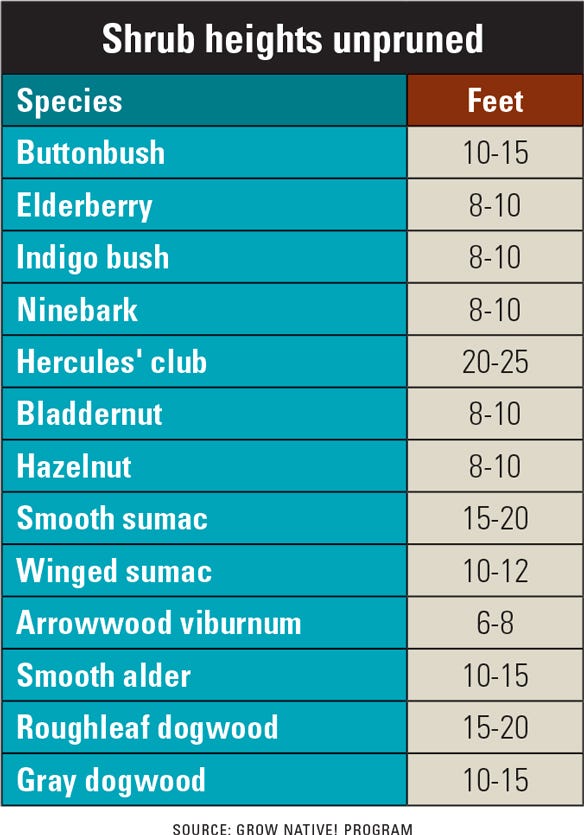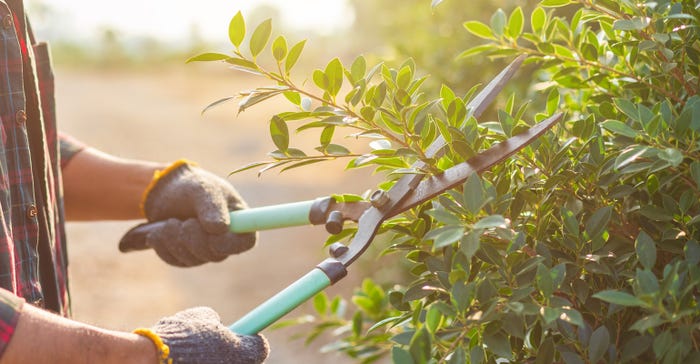June 24, 2022

By midsummer, small trees and large shrubs grow upward, out and bend over from the weight of leaves and fruits. Unfortunately, heavy, drooping branches invade sidewalks and patios, block views, and brush up against buildings or even cars.
Trimming back these stray branches in summer won’t harm them, although pruning woody plants is normally done in winter.
Certain large species do this more than others, especially in the lush environment of a mulched and watered garden. Here are 12 multistemmed species and their average unpruned mature heights:

The above species have the potential to grow into small multistemmed trees without pruning. The more shade they get, the taller and lankier they grow. This can be ideal if you want to see through them and enjoy the trunks and bark, because the mass of foliage is above the eye in this situation. You can further enhance this see-through effect by trimming away the lower leaves and short-side branchlets.
But if your long-term goal is to keep these types of plants lower and shrubby, or create an eye-level screen, these are great native plant choices.
Pruning tips
To take advantage of their ability to screen, prune shrubs every year or two. This should happen after plants are established about two to three years.
Remove one-quarter to one-third of the stems (the oldest) to the ground, every winter or two. This is a process called rejuvenation. It forces multistemmed woody plants to continuously generate new stems and densely grow leaves and branchlets in the lower parts of the stems, blocking all views.
The decision to encourage small trees versus lower-growing shrubs is your choice. Nowhere is it written that gray dogwood in a garden is a shrub or a tree, because it can be either. There is no right or wrong way to go. Plants need to work for your situation.
That said, keep in mind that maintaining multistemmed shrubs takes some effort, and it generates debris. Also know that plants flower, fruit and grow more vigorously when they are located in more sun. Maintaining trees and shrubs in the shade is less intensive because they produce fewer stems and branches.
Shrubs get crowded
The nature of multistemmed shrubs is that they grow wider over time, some more quickly than others. For example, the distance between hazelnut, ninebark, buttonbush, bladdernut, alder, dogwood and arrowwood stems is 4 to 6 inches (or less). The stems are congested and difficult to prune, and therefore they are considered densely clumping shrubs, although their diameter continually increases over time. Because of this, they make excellent screens.
Hercules club has branches 2 to 4 feet apart (or more). Indigobush stems are about 1 foot apart and somewhat open and spreading in nature in part shade. Because of this, their screening ability is diminished. They are more see-through in nature and may require a groundcover companion plant such as golden groundsel to prevent weeds. Elderberry and sumac also have stems 1 to 2 feet apart, and they tend to grow densely in full sun and more open in part shade.

While many plants, trees and shrubs are pruned in winter, there are native species that can take a good cutting during summer months — especially if they are taking over barns, buildings or walkways.
Multistemmed native woody plants have many applications in the garden. Getting to know each plant is key to finding success with small specimen trees or low shrubby screens. Resources that will help you learn about these plants can be found in the book “Tried and True Missouri Native Plants for Your Yard.” Also check out the Grow Native! and Shaw Nature Reserve websites for gardening tips and plant information.
And lastly, don’t be afraid to try a new native woody plant. You may find a new use for a native plant in your own backyard.
Woodbury, a horticulturist, is a curator of the Whitmore Wildflower Garden at Shaw Nature Reserve in Gray Summit and an adviser to the Missouri Prairie Foundation’s Grow Native! program.
About the Author(s)
You May Also Like




